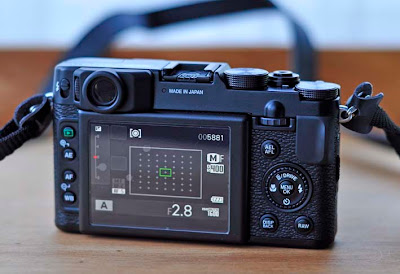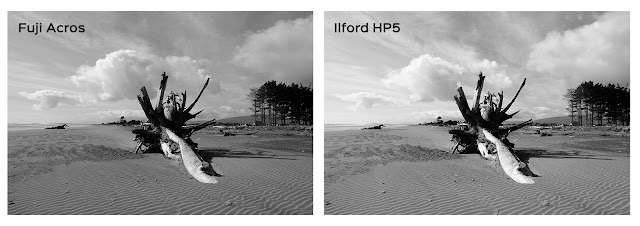Setting up the Fuji X10
Without wanting to tell you all how to 'suck eggs' (as the saying goes), what follows is a brief description of how I have initially set up the Fuji X10 for shooting.
Of course the usual caveats apply - this is my shooting style, my output decisions, my workflow... blah, blah, blah. You get the idea. So what follows, for what it's worth, should be taken with a grain of salt. But it might help some who are setting their camera up for the first time, at least as a starting point into developing their own shooting style?
First, I always shoot in 'A' - Aperture priority. Why? It's a throwback from shooting on film and with DSLR's I suppose - but I think in apertures (specifically for control over depth of field - 'dof'). Now I'm aware that due to the smaller sensor in the X10 (which, although large for a 'point-and-shoot', is still relatively small compared to the APS-C sized sensors in a DSLR), control over dof will be somewhat limited. I have yet to explore the dof field control for portraits with the camera (the topic of a future post), but I'm aware that it won't be as significant as with my Nikon D90 and an 85mm f1.8. But I still think in apertures, so that's my shooting style, and how I've set the X10 up initially.
What goes along with this is the use of the central auto-focus area. Again, this is probably a throwback to the 'good old days' of film, where you had to focus manually (gasp) with the central portion of the screen and recompose. I know life has moved on, and we have auto area focus and what-not, but it just feels comfortable to do the 'focus and re-compose' dance. I may eventually try face detection auto focus for portraits - but 90% of the time I'm in central focus lock-down.
Another reason for this has to do with the viewfinder on the X10. The great news is that the X10 has an optical viewfinder - a major selling point for me. I hate the 'hold-the-camera-at-arms-length-and-use-live-view' way of composing photos forced on to us with cameras that no longer have viewfinders. It's unnatural, uncomfortable, unstable, and looks ridiculous. But I'm also aware that there are a whole new generation of photographers for whom this is the 'norm'. Not me. I always hold the camera up to me eye - another throwback from film and DLSR's (can you see a pattern emerging here?). I know that this shows my age, but I also honestly believe it's still the best way to hold, use and shoot with any camera if you want sharp images.
So great news, the X10 has an optical viewfinder. The bad news (maybe), is that it has absolutely no shooting or focusing information in it when you hold it up to your eye. It does zoom with the lens, but doesn't confirm focus - other than the camera itself emitting a beep and a green confirmation light blinking next to the eyepiece. To be honest, that's enough for me - especially in conjunction with the central autofocus point. I place the subject centrally, press the shutter half way, wait for the beep and flashing green light, recompose, and shoot. Easy.
The viewfinder itself is reasonably big on such a small compact camera, very bright, and if you shoot in the 3:2 format (which resembles film), then parallax isn't a big issue. The viewfinder is only 85% coverage, but when you shoot in 3:2 it equates roughly to what-you-see-is-what-you-get in the viewfinder. So the X10's optical finder isn't as useless as some internet reviewers have made it out to be, although Im sure the X20's information overlay will be a worthwhile upgrade for some.
As for the rest of the settings? I shoot in Fine Medium JPEG (not RAW, for reasons I will explain in the next post), with DR (Dynamic Range) set to 400%, Auto ISO topping out at 1600, and Provia film simulation mode. The research I did before buying the X10 suggests that this is something close to the optimal setup, so that's where I'm starting.
Other camera settings are purely personal - I set the LCD to -1, the shutter sound to #3, the volume down to 1, the display on the back is set to 'Info' (not Live View), and I have the image come up for 1.5 secs after it's taken - to quickly check exposure and composition since I use the viewfinder. Your needs may, of course, vary.
As I get to know and shoot with the camera more, I may tweak these initial settings - or I may not? I've set all the above into C1 (Custom Setting), so whenever I do tweak things a little (or a lot), I can always return to 'normal' by switching to C1.
The X10 is a fully featured and complex piece of kit. It may be little, but it packs a lot. And although it enjoys 'point-and-shoot' status, it's not really a simple point and shoot camera. Which is why I (and probably you) bought it in the first place. In a months time this will be my only camera, quite a scary thought for someone who has shot with an SLR all their life.
But I'm quietly confident that the camera can produce the goods, if set up correctly. And in the coming months, that's exactly what I aim to find out.
Of course the usual caveats apply - this is my shooting style, my output decisions, my workflow... blah, blah, blah. You get the idea. So what follows, for what it's worth, should be taken with a grain of salt. But it might help some who are setting their camera up for the first time, at least as a starting point into developing their own shooting style?
 |
| Shooting info on the back on the X10 |
What goes along with this is the use of the central auto-focus area. Again, this is probably a throwback to the 'good old days' of film, where you had to focus manually (gasp) with the central portion of the screen and recompose. I know life has moved on, and we have auto area focus and what-not, but it just feels comfortable to do the 'focus and re-compose' dance. I may eventually try face detection auto focus for portraits - but 90% of the time I'm in central focus lock-down.
Another reason for this has to do with the viewfinder on the X10. The great news is that the X10 has an optical viewfinder - a major selling point for me. I hate the 'hold-the-camera-at-arms-length-and-use-live-view' way of composing photos forced on to us with cameras that no longer have viewfinders. It's unnatural, uncomfortable, unstable, and looks ridiculous. But I'm also aware that there are a whole new generation of photographers for whom this is the 'norm'. Not me. I always hold the camera up to me eye - another throwback from film and DLSR's (can you see a pattern emerging here?). I know that this shows my age, but I also honestly believe it's still the best way to hold, use and shoot with any camera if you want sharp images.
So great news, the X10 has an optical viewfinder. The bad news (maybe), is that it has absolutely no shooting or focusing information in it when you hold it up to your eye. It does zoom with the lens, but doesn't confirm focus - other than the camera itself emitting a beep and a green confirmation light blinking next to the eyepiece. To be honest, that's enough for me - especially in conjunction with the central autofocus point. I place the subject centrally, press the shutter half way, wait for the beep and flashing green light, recompose, and shoot. Easy.
The viewfinder itself is reasonably big on such a small compact camera, very bright, and if you shoot in the 3:2 format (which resembles film), then parallax isn't a big issue. The viewfinder is only 85% coverage, but when you shoot in 3:2 it equates roughly to what-you-see-is-what-you-get in the viewfinder. So the X10's optical finder isn't as useless as some internet reviewers have made it out to be, although Im sure the X20's information overlay will be a worthwhile upgrade for some.
As for the rest of the settings? I shoot in Fine Medium JPEG (not RAW, for reasons I will explain in the next post), with DR (Dynamic Range) set to 400%, Auto ISO topping out at 1600, and Provia film simulation mode. The research I did before buying the X10 suggests that this is something close to the optimal setup, so that's where I'm starting.
 |
| One of the first images shot with the above settings |
As I get to know and shoot with the camera more, I may tweak these initial settings - or I may not? I've set all the above into C1 (Custom Setting), so whenever I do tweak things a little (or a lot), I can always return to 'normal' by switching to C1.
The X10 is a fully featured and complex piece of kit. It may be little, but it packs a lot. And although it enjoys 'point-and-shoot' status, it's not really a simple point and shoot camera. Which is why I (and probably you) bought it in the first place. In a months time this will be my only camera, quite a scary thought for someone who has shot with an SLR all their life.
But I'm quietly confident that the camera can produce the goods, if set up correctly. And in the coming months, that's exactly what I aim to find out.



Great post, I have a X10 and it was very helpful.
ReplyDeleteYou obviously come from the same 35mm background as I do. Having just picked up a cheap X10 on ebay as an impulse purchase I soon arrived at almost the same settings as you (apart from shooting in Program rather than Aperture mode). Of course, I'm rather late to the game and you've probably moved on...
ReplyDelete